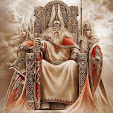Maya mythology is part of Mesoamerican mythology and comprises all of the Maya tales in which personified forces of nature, deities, and the heroes interacting with these play the main roles. Other parts of Maya oral tradition (such as animal tales and many moralising stories) do no properly belong to the domain of mythology but rather to legend and folk tale.
The oldest written Maya myths date from the 16th century and are found in historical sources from the Guatemalan Highlands. The most important of these documents is the Popol Vuh which contains Quichean creation stories and some of the adventures of the Hero Twins, Hunahpu and Xbalanque.
Yucatán is an equally important region. The Books of Chilam Balam contain mythological passages of great antiguity, and mythological fragaments are found scattered among the early-colonial Spanish chronicles and reports, chief among them Diego de Landa's Relacion, and in the dictionaries compiled by the early missionaries.
In the 19th and 20th centuries, anthropologists and local folklorists committed many stories to paper. Even though most Maya tales are the results of an historical process in which Spanish narrative traditions interacted with native ones, some of the tales reach bach well into pre-Spanish times.
Now, at the beginning of the 21st century, the transmission of traditional tales has entered its final stage. Fortunately, however, this is also a time in which the Mayas themselves have begun to salvage and pubblish the precious tales of their parents and grandparents.





